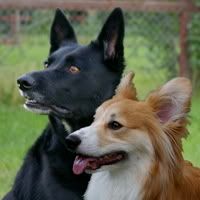Sit
This is probably the easiest of the two.
- * Hold your clicker in one hand, (and behind your back/in your pocket if it distracts your puppy) and hold a very valuable treat inside your other hand, such as a tiny piece of hot dog, or chicken. (ball it in your fist if your puppy is crafty and good at snatching it).
- * Show your hand holding the treat to your puppy, and slowly move it back over his head, and slightly up. His nose should follow, as he's looking for the treat, and this movement should naturally entice him into sitting.
- * Once his butt hits the floor, click and treat.
- * Repeat the above steps. You should notice that each time, he'll start sitting faster, until he figures out that sitting is what gets him the reward, and then he'll do it right away. At this point, you connect a word with the action of sitting.
- * Next time you lure him into the sit, as he's in the action of sitting (not before, and not after), say "sit" (or whatever you feel like calling it), then click and treat.
- * Repeat! After lots of repetition of this in many 5-minute training sessions, you'll have an awesome sitting puppy!
Down

Down can be a little more difficult, because the act of lying down puts a dog in a vulnerable position. Some dogs can be nervous or scared of this, so keep that in mind while training. If they don't start downing right away, it's not out of stubbornness, but more likely out of nervousness.
- * It's easiest to start off by putting your puppy in a sit.
- * With your clicker in one hand and the treat balled in the other, show your puppy your treat hand, and slowly move that hand down and between his front legs. His nose should follow while he tries to get the treat. He may not lie down right away.
- * Try moving your treat hand slowly forward from between his front paws by a few inches. This may lure him into a down, but some puppies still aren't convinced.
- * Hold the treat, balled in your fist, down on the ground, either a few inches in front of your puppy's front paws, or just between them, and wait.
- * If he gets up from his sit, put him back in the sit and simply repeat the above steps.
- * Most puppies will naturally lie down and start trying to work out a way to get that treat out of your hand, which is what you want. This may take several seconds, or a few minutes. It's important to be patient. If he gets distracted just lure him back and start over. As soon as he goes into lying down to work on getting the treat out of your hand, click and treat. Repeat!
- * As you did above with sit, once he knows what you want, connect a word to this action, by saying something like "down" or "lay down" as he is in the process of lying down (not before or after, as above). And repeat!
These methods are easy, humane and help your dog learn to work out problems, so I hope they will work for you as well as they did for me! =)
